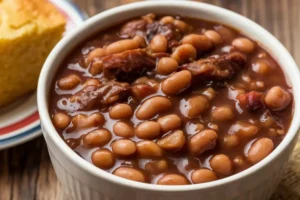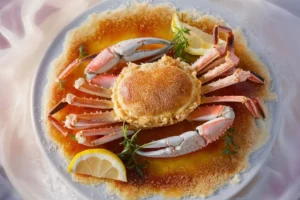Burger Sauce vs. Thousand Island Dressing: Key Differences Explained
When it comes to condiments, few sauces have garnered as much attention and adoration as burger sauce and Thousand Island dressing. But how do these two popular condiments stack up against each other? Are they truly the same, or does one stand out as the better choice? In this article, we’ll explore the similarities and differences between burger sauce vs. Thousand Island dressing, helping you decide which one is right for your next meal.
What is Burger Sauce? A Look at the First Contender in Burger Sauce vs. Thousand Island Dressing
Burger sauce is a creamy, tangy, and slightly sweet condiment that is a favorite for enhancing the flavor of burgers. It typically contains:
- Mayonnaise: The base of the sauce, providing a rich, creamy texture.
- Ketchup: Adds sweetness and a touch of acidity.
- Pickle Relish: Brings a tangy crunch to the mix.
- Mustard: Offers a subtle heat.
- Vinegar: Enhances the tanginess.
- Spices: Commonly includes garlic powder, onion powder, and paprika.
These ingredients combine to create a sauce that’s versatile and flavorful, making it a perfect match for grilled meats. When comparing burger sauce vs. Thousand Island dressing, the tanginess of the vinegar and mustard is a key differentiator.
For more on how to craft a delicious burger sauce, you might be interested in this detailed guide to burger sauce recipes, which offers a variety of options to suit different tastes.
What is Thousand Island Dressing? Comparing It in the Burger Sauce vs. Thousand Island Debate
Thousand Island dressing is a classic sauce that dates back over a century, often used as a salad dressing or sandwich spread. It typically consists of:
- Mayonnaise: Like burger sauce, it forms the creamy base.
- Ketchup: Provides sweetness and a vibrant color.
- Sweet Pickle Relish: Similar to burger sauce but generally sweeter.
- Hard-Boiled Egg: Adds a rich, unique flavor (optional).
- Worcestershire Sauce: Contributes a savory depth.
- Lemon Juice or Vinegar: For acidity.
- Chili Sauce or Hot Sauce: Adds a bit of heat (optional).
The combination of these ingredients creates a sauce that’s more complex than burger sauce, with a sweeter and tangier profile. For more on the history of Thousand Island dressing and its place in American cuisine, check out this detailed article.
When comparing burger sauce vs. Thousand Island dressing, one might also consider the famous Big Mac Sauce and how it draws inspiration from both condiments.
Burger Sauce vs. Thousand Island Dressing: Ingredient Comparison
While both burger sauce and Thousand Island dressing share some common ingredients like mayonnaise, ketchup, and pickle relish, they differ in their flavor profiles:
- Burger Sauce: Tends to be tangier with a more pronounced pickle flavor, thanks to the inclusion of vinegar and mustard.
- Thousand Island Dressing: Typically sweeter, especially if it includes sweet pickle relish and Worcestershire sauce.
The addition of ingredients like hard-boiled egg and Worcestershire sauce in Thousand Island dressing adds a layer of complexity that burger sauce usually lacks. This difference is key to their unique identities.
Discover how to make the best homemade burger sauce that suits your taste preferences perfectly.
Usage in Popular Burger Chains: Burger Sauce vs. Thousand Island Dressing in Popular Burger Chains
The debate over whether burger sauce and Thousand Island dressing are the same often arises from their use in popular fast-food chains. Many of these chains have developed their own versions of “special sauce,” which are often variations of one or both of these classic condiments.
The Big Mac Sauce Debate
One of the most famous examples is McDonald’s Big Mac Sauce, which is often compared to Thousand Island dressing. While the exact recipe is a closely guarded secret, it’s widely believed that Big Mac Sauce shares many similarities with Thousand Island, particularly in its use of mayonnaise, ketchup, and relish. However, the addition of mustard and a different spice blend gives Big Mac Sauce a flavor that’s distinct from traditional Thousand Island.
Other Fast-Food Special Sauces
- In-N-Out’s Spread: This popular West Coast chain uses a “spread” on its burgers that’s remarkably similar to Thousand Island dressing. The spread is made with mayonnaise, ketchup, and relish, much like Thousand Island, but it’s slightly tangier and less sweet, making it closer to a burger sauce.
- Shake Shack’s ShackSauce: Shake Shack’s secret sauce is another example of a special sauce that draws inspiration from both burger sauce and Thousand Island dressing. It’s creamy, tangy, and slightly smoky, with a complex flavor that enhances their signature burgers.
The Role of Special Sauces in Branding
These “special sauces” have become integral to the branding of these fast-food chains, offering a signature taste that sets them apart from their competitors. Whether it’s the familiar tang of Big Mac Sauce or the unique blend of flavors in Shake Shack’s ShackSauce, these sauces have helped define the identity of these restaurants and have cemented their place in popular culture.
Homemade vs. Store-Bought: The Pros and Cons
When it comes to enjoying burger sauce or Thousand Island dressing at home, you have two main options: buying a pre-made version from the store or making your own from scratch. Each approach has its benefits and drawbacks, and the right choice for you will depend on your preferences and needs.
Homemade Sauce
Pros:
- Customizable Flavor: When you make your own sauce, you have complete control over the ingredients, allowing you to adjust the flavor to your liking. Want it tangier? Add more vinegar. Prefer it sweeter? Increase the amount of ketchup or relish.
- Fresher Taste: Homemade sauces often taste fresher and more vibrant than store-bought versions, as they don’t contain preservatives or artificial ingredients.
- No Preservatives: Making your own sauce means you can avoid preservatives and artificial additives, making it a healthier option.
Cons:
- Time-Consuming: Making sauce from scratch takes time, especially if you’re making a large batch or experimenting with different flavors.
- Shorter Shelf Life: Without preservatives, homemade sauces don’t last as long as store-bought ones. You’ll need to use them up quickly or store them in the fridge.
Store-Bought Sauce
Pros:
- Convenience: Store-bought sauces are ready to use straight from the bottle, making them a convenient option for busy weeknights or impromptu barbecues.
- Consistency: When you buy a pre-made sauce, you know exactly what you’re getting. The flavor is consistent, so there’s no guesswork involved.
- Longer Shelf Life: Thanks to preservatives, store-bought sauces have a longer shelf life, making them a good option for those who don’t use sauce regularly.
Cons:
- Limited Customization: With a pre-made sauce, you’re stuck with the flavor profile chosen by the manufacturer. If it’s not quite to your liking, you’ll need to doctor it up with additional ingredients.
- Potential Additives: Many store-bought sauces contain preservatives, artificial flavors, and other additives that some people prefer to avoid.
Health Considerations
While both burger sauce and Thousand Island dressing are delicious, they’re also indulgent, high-calorie condiments that should be used in moderation. Here’s a look at the nutritional profiles of both sauces and what you should consider when adding them to your meals.
Caloric Content
Both sauces are calorie-dense due to their high-fat content, primarily from the mayonnaise base:
- Burger Sauce: A typical serving (1 tablespoon) of burger sauce contains around 90-100 calories, with most of those calories coming from fat.
- Thousand Island Dressing: Similarly, a serving of Thousand Island dressing also contains around 90-100 calories per tablespoon, though this can vary depending on the recipe.
Fat Content
The fat content in both sauces is significant, again due to the mayonnaise base:
- Burger Sauce: A tablespoon of burger sauce typically contains about 9-10 grams of fat.
- Thousand Island Dressing: A tablespoon of Thousand Island dressing contains a similar amount of fat, though it may be slightly higher if the recipe includes ingredients like hard-boiled egg or additional oils.
Sugar Content
The sugar content in these sauces varies, with Thousand Island dressing generally being sweeter:
- Burger Sauce: Contains about 1-2 grams of sugar per tablespoon, mainly from ketchup.
- Thousand Island Dressing: Can contain 2-3 grams of sugar per tablespoon, especially if sweet pickle relish is used.
Sodium Content
Both sauces are also relatively high in sodium, which is something to keep in mind if you’re watching your salt intake:
- Burger Sauce: Typically contains around 150-200 mg of sodium per tablespoon.
- Thousand Island Dressing: Can contain a similar amount of sodium, though it may be slightly higher depending on the recipe.
Versatility in Cooking
One of the reasons both burger sauce and Thousand Island dressing have remained popular for so long is their versatility in the kitchen. While each sauce has its traditional uses, they can also be employed in a variety of creative ways.
Burger Sauce Uses
- Classic Burger Topping: As the name suggests, burger sauce is a natural choice for topping burgers, adding a creamy, tangy contrast to the savory meat.
- Sandwich Spread: Spread it on sandwiches for an extra layer of flavor, especially on club sandwiches, BLTs, or turkey sandwiches.
- Dipping Sauce: Use it as a dip for fries, onion rings, or chicken nuggets. It’s also great for dipping grilled vegetables or even pizza crusts.
- Salad Dressing: Thin it out with a bit of vinegar or lemon juice to create a quick, creamy salad dressing that pairs well with hearty greens.
- Marinade: Mix burger sauce into a marinade for chicken, pork, or tofu to add flavor before grilling or baking.
Thousand Island Dressing Uses
- Salad Dressing: The most common use for Thousand Island dressing is as a salad dressing, particularly on iceberg or wedge salads. Its sweetness pairs well with the crispness of the lettuce.
- Sandwich Spread: A key ingredient in a classic Reuben sandwich, Thousand Island dressing complements the tangy sauerkraut and salty corned beef perfectly.
- Seafood Sauce: Use it as a dipping sauce for shrimp cocktails, crab cakes, or fried seafood. It’s also great on a seafood salad.
- Burger Topping: While not as common as burger sauce, Thousand Island dressing can be used as a burger topping for a sweeter, more complex flavor.
- Deviled Eggs: Mix Thousand Island dressing with the yolk mixture for a new twist on deviled eggs.
FAQs
Is Burger Sauce the Same as Thousand Island Dressing?
No, while they share some ingredients like mayonnaise, ketchup, and pickle relish, burger sauce and Thousand Island dressing have distinct flavor profiles and uses. Burger sauce is tangier and often spicier, while Thousand Island dressing is sweeter and more complex.
What Are the Main Ingredients in Burger Sauce?
Burger sauce typically includes mayonnaise, ketchup, pickle relish, mustard, vinegar, and spices like garlic powder, onion powder, and paprika.
Can I Use Thousand Island Dressing as a Substitute for Burger Sauce?
Yes, you can use Thousand Island dressing as a substitute for burger sauce, but keep in mind that it will add a sweeter and more complex flavor to your burger or sandwich.
What Makes Big Mac Sauce Different?
Big Mac Sauce is often considered a variation of Thousand Island dressing, but it includes mustard and a different spice blend, giving it a unique tangy flavor.
How Can I Make My Own Burger Sauce at Home?
To make your own burger sauce, simply mix mayonnaise, ketchup, pickle relish, mustard, and spices to taste. Adjust the ingredients to create the perfect flavor balance for your palate.
Conclusion
In conclusion, while burger sauce and Thousand Island dressing may seem similar at first glance, they each bring something unique to the table. Whether you’re dressing up a burger or adding flavor to a salad, understanding the differences between these two sauces will help you make the right choice for your next meal. So why not try making your own versions of each and see which one becomes your new favorite? With their versatility and flavor, both sauces are sure to enhance your culinary creations.




